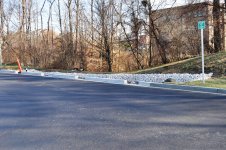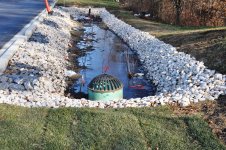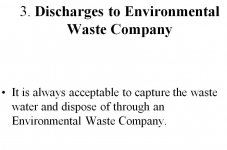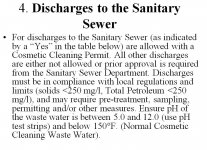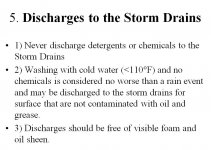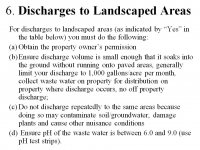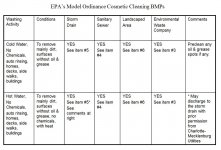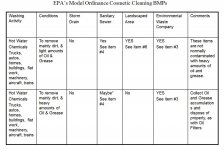So what was wrong with this Robert? Why did you have to go and screw it up with the "emulsifier" garbage? I see no mention of hot water being the same as so@p here.
Here is and excerpt from the same source as the "waters of the state" section:
(13) "Pollutant" means dredged spoil, solid waste, incinerator residue, sewage, garbage, sewage sludge, filter backwash, munitions, chemical wastes, biological materials, radioactive materials, heat, wrecked or discarded equipment, rock, sand, cellar dirt, and industrial, municipal, and agricultural waste discharged into any water in the state.
Notice it says "heat". There is a big difference between a powerwasher putting out 6 gallons per minute and the runoff reaching ambient temperature as it travels towards it's destination and a power plant dumping a million gallons of boiling water into the lake. These regulations were made for THOSE types of discharge.
Notice it didn't say anything about filtered water but rather filter BACKWASH. This is far different from us in this industry stopping pollution with oil socks and other filtration.
Fort Worth FAQ's at
http://fortworthtexas.gov/uploadedF...uality/Power_Washer_Permit/PowerWasherFAQ.pdf
Mobile Commercial Cosmetic Cleaning Permit
<dir>
<dir>
<dir>
<dir>
<dir>
<dir>
Frequently Asked Questions
</dir>
</dir>
</dir>
</dir>
</dir>
</dir>
[FONT=Times New Roman,Times New Roman][FONT=Times New Roman,Times New Roman]Why do we have a permit?
[/FONT][/FONT][FONT=Times New Roman,Times New Roman][FONT=Times New Roman,Times New Roman][/FONT][/FONT][FONT=Times New Roman,Times New Roman]
[FONT=Times New Roman,Times New Roman][/FONT][/FONT][FONT=Times New Roman,Times New Roman]
[FONT=Times New Roman,Times New Roman]In 1993, Environmental Management tested 560 sites within the city limits. We discovered detergents in over 50% of these sites making detergents the most frequently encountered pollutant in the city. Cosmetic cleaning is a significant source of these detergents and because the EPA is giving the city five (5) years to show a decrease in the pollutants at the 560 sites the city had to enact specific regulations for cosmetic cleaning. The City of Fort Worth’s TPDES Permit requires regulation of discharges.
[/FONT][/FONT]
[FONT=Times New Roman,Times New Roman][FONT=Times New Roman,Times New Roman]When did the "no off-property discharge" regulation go into effect?
[/FONT][/FONT][FONT=Times New Roman,Times New Roman][FONT=Times New Roman,Times New Roman][/FONT][/FONT][FONT=Times New Roman,Times New Roman]
[FONT=Times New Roman,Times New Roman][/FONT][/FONT][FONT=Times New Roman,Times New Roman]
[FONT=Times New Roman,Times New Roman]It has been illegal to discharge any type of wastewater off-property in Fort Worth since the turn of the century. However, the regulations had not been heavily enforced until recently so many cosmetic cleaners were under the mistaken impression that it was legal for them to discharge their wash water to the storm drain.
[/FONT][/FONT]
[FONT=Times New Roman,Times New Roman][FONT=Times New Roman,Times New Roman]What type of operation is regulated by the permit?
[/FONT][/FONT][FONT=Times New Roman,Times New Roman][FONT=Times New Roman,Times New Roman][/FONT][/FONT][FONT=Times New Roman,Times New Roman]
[FONT=Times New Roman,Times New Roman][/FONT][/FONT][FONT=Times New Roman,Times New Roman]
[FONT=Times New Roman,Times New Roman]Under the ordinance, mobile commercial cosmetic cleaning means "power washing, steam cleaning, and any other mobile cosmetic cleaning operation, of vehicles and/or exterior surfaces, engaged in for commercial purposes." Facilities which use their own employees for power washing are not regulated. However, they still must adhere to the prohibitions of the storm water ordinance regarding discharges to the storm sewer.
[/FONT][/FONT]
[FONT=Times New Roman,Times New Roman][FONT=Times New Roman,Times New Roman]Who sets the fees for the permits?
[/FONT][/FONT][FONT=Times New Roman,Times New Roman][FONT=Times New Roman,Times New Roman][/FONT][/FONT][FONT=Times New Roman,Times New Roman]
[FONT=Times New Roman,Times New Roman][/FONT][/FONT][FONT=Times New Roman,Times New Roman]
[FONT=Times New Roman,Times New Roman]The City Council sets all fees for all programs run in the city.
[/FONT][/FONT]
[FONT=Times New Roman,Times New Roman][FONT=Times New Roman,Times New Roman]Why do I have to pay a fee?
[/FONT][/FONT][FONT=Times New Roman,Times New Roman][FONT=Times New Roman,Times New Roman][/FONT][/FONT][FONT=Times New Roman,Times New Roman]
[FONT=Times New Roman,Times New Roman][/FONT][/FONT][FONT=Times New Roman,Times New Roman]
[FONT=Times New Roman,Times New Roman]The city is allowed by law to cover all administrative costs of a specific program by charging a fee. The fee cannot be used just to make money for the Department. Your fee pays for all of the paperwork, computer data, sticker costs and labor needed to run this permit program.
[/FONT][/FONT]
[FONT=Times New Roman,Times New Roman][FONT=Times New Roman,Times New Roman]Why do I need to put the numbers and stickers on my rig?
[/FONT][/FONT][FONT=Times New Roman,Times New Roman][FONT=Times New Roman,Times New Roman][/FONT][/FONT][FONT=Times New Roman,Times New Roman]
[FONT=Times New Roman,Times New Roman][/FONT][/FONT][FONT=Times New Roman,Times New Roman]
[FONT=Times New Roman,Times New Roman]When an inspector drives by and sees you in operation he is going to stop and observe your set up and he will need to know if you are holding a valid permit. If he sees your registration numbers and sticker on your rig, then he will not have to interrupt you and cause you to lose valuable work time by having you dig through your truck looking for your paperwork. In fact, the only time you should have to talk to an inspector is when you have a question.
[/FONT][/FONT]
[FONT=Times New Roman,Times New Roman][FONT=Times New Roman,Times New Roman]I sometimes pull the spray rig out of my truck and use it as my private vehicle. Do I have to put numbers and stickers on the outside of my truck? -or- I paid several hundred dollars for a custom paint job on my truck and trailer. Do I have to put these stickers and numbers on and ruin the look of my rig?
[/FONT][/FONT][FONT=Times New Roman,Times New Roman][FONT=Times New Roman,Times New Roman][/FONT][/FONT][FONT=Times New Roman,Times New Roman]
[FONT=Times New Roman,Times New Roman][/FONT][/FONT][FONT=Times New Roman,Times New Roman]
[FONT=Times New Roman,Times New Roman]The answer to this is no. We do not want anyone to ruin a great paint job or make their vehicle look like strictly a business truck. You can place the numbers and stickers anywhere you wish as long as they are visible. For instance, you could place them on the water tank or somewhere on the side of the spray rig. You could also place them on some sort of placard that could be removed when you are not using your truck for business purposes.
[/FONT][/FONT]
[FONT=Times New Roman,Times New Roman][FONT=Times New Roman,Times New Roman]Will private citizens washing cars in their driveways be required to obtain a permit? After all, their wash water is entering the streets and storm drains.
[/FONT][/FONT][FONT=Times New Roman,Times New Roman][FONT=Times New Roman,Times New Roman][/FONT][/FONT][FONT=Times New Roman,Times New Roman]
[FONT=Times New Roman,Times New Roman][/FONT][/FONT][FONT=Times New Roman,Times New Roman]
[FONT=Times New Roman,Times New Roman]The EPA has exempted residential car washing from the storm water rules so private citizens do not need any sort of permit. However, the city does recognize this activity as another source of detergents that enter our waterways and encourages residents to consider alternative car washing methods. The Environmental Management and the Water Department distribute this information through brochures, newspaper articles, water bill inserts, programs to neighborhood associations, classroom lectures and a host of other public education activities.
[/FONT][/FONT]
[FONT=Times New Roman,Times New Roman][FONT=Times New Roman,Times New Roman]I use biodegradable detergents. Why can't I discharge these to the storm drain?
[/FONT][/FONT][FONT=Times New Roman,Times New Roman][FONT=Times New Roman,Times New Roman][/FONT][/FONT][FONT=Times New Roman,Times New Roman]
[FONT=Times New Roman,Times New Roman][/FONT][/FONT][FONT=Times New Roman,Times New Roman]
[FONT=Times New Roman,Times New Roman]The term "biodegradable" simply means that the product will not harm bacteria in the sewage treatment plant, and that it breaks down faster than more conventional products. A biodegradable detergent can cause a fish kill in a creek just as fast as any other type of detergent. We do appreciate the use of biodegradable products because they are much gentler on the treatment plant when you properly dispose of them to the sanitary sewer.
[/FONT][/FONT]
[FONT=Times New Roman,Times New Roman][FONT=Times New Roman,Times New Roman]Do I need to test my water if I am not using a recycling rig?
[/FONT][/FONT][FONT=Times New Roman,Times New Roman][FONT=Times New Roman,Times New Roman][/FONT][/FONT][FONT=Times New Roman,Times New Roman]
[FONT=Times New Roman,Times New Roman][/FONT][/FONT][FONT=Times New Roman,Times New Roman]
[FONT=Times New Roman,Times New Roman]No. However, all limitations that are associated with discharges to the sanitary sewer do apply to you and you could be fined by the Water Department for exceeding these limitations. You should always be aware of what you are discharging to the sanitary sewer and take all necessary precautions needed to keep your discharge as clean as possible.
[/FONT][/FONT]
[FONT=Times New Roman,Times New Roman][FONT=Times New Roman,Times New Roman]Do I need to supply a map of my discharge points if I don't use a wash water recycling unit?
[/FONT][/FONT][FONT=Times New Roman,Times New Roman][FONT=Times New Roman,Times New Roman][/FONT][/FONT][FONT=Times New Roman,Times New Roman]
[FONT=Times New Roman,Times New Roman][/FONT][/FONT][FONT=Times New Roman,Times New Roman]
[FONT=Times New Roman,Times New Roman]No. This is only required of those using recycling units because the Water Department must have a method of monitoring these points to comply with EPA regulations.
[/FONT][/FONT]
[FONT=Times New Roman,Times New Roman][FONT=Times New Roman,Times New Roman]May I wash a parking lot or gas station with cold (or hot) water only and discharge it to the storm drain?
[/FONT][/FONT][FONT=Times New Roman,Times New Roman][FONT=Times New Roman,Times New Roman][/FONT][/FONT][FONT=Times New Roman,Times New Roman]
[FONT=Times New Roman,Times New Roman][/FONT][/FONT][FONT=Times New Roman,Times New Roman]
[FONT=Times New Roman,Times New Roman]Probably not. Even though the ordinance states that you can discharge to the storm drain if you don’t use detergents, degreasers, etc., you will probably be washing oil, grease, metals and dirt off property which will violate the ordinance. This exemption was designed for cosmetic cleaners washing objects such as sidewalks, headstones, walls and other things that are unlikely to be affected by the normal pollutants. Remember, it is not just the chemicals you use; it is also the pollutants you wash off that are banned from the storm drain system.
[/FONT][/FONT]
[FONT=Times New Roman,Times New Roman][FONT=Times New Roman,Times New Roman]Is dirt considered a pollutant?
[/FONT][/FONT][FONT=Times New Roman,Times New Roman][FONT=Times New Roman,Times New Roman][/FONT][/FONT][FONT=Times New Roman,Times New Roman]
[FONT=Times New Roman,Times New Roman][/FONT][/FONT][FONT=Times New Roman,Times New Roman]
[FONT=Times New Roman,Times New Roman]Dirt itself is not considered a true pollutant. However, the State of Texas does have a numerical standard for discharges of dirt to waterways. This standard is known as Total Suspended Solids (TSS). So even if you are not washing pollutants off property and you are allowed to discharge to the storm drain, be aware that too much dirt will put you in violation of the TSS Standard and you could be fined by the city and the state.
[/FONT][/FONT]
[FONT=Times New Roman,Times New Roman][FONT=Times New Roman,Times New Roman]How do I access the sanitary sewer line to properly dispose of my wash water?
[/FONT][/FONT][FONT=Times New Roman,Times New Roman][FONT=Times New Roman,Times New Roman][/FONT][/FONT][FONT=Times New Roman,Times New Roman]
[FONT=Times New Roman,Times New Roman][/FONT][/FONT][FONT=Times New Roman,Times New Roman]
[FONT=Times New Roman,Times New Roman]You can access the line through a clean out stub (where the plumber sends the drain snake), a sink, a toilet or some floor drains. Be aware that most floor drains located outside go to the storm sewer rather than the sanitary sewer, so be sure you know how things are plumbed before discharging to floor drains. If there is a car wash or some sort of sand or grit trap on the property, discharge into those as they will help clean your wash water before it enters the pipe. Never open a manhole. Opening manholes is not only extremely dangerous; it is also against the law
[/FONT][/FONT]



